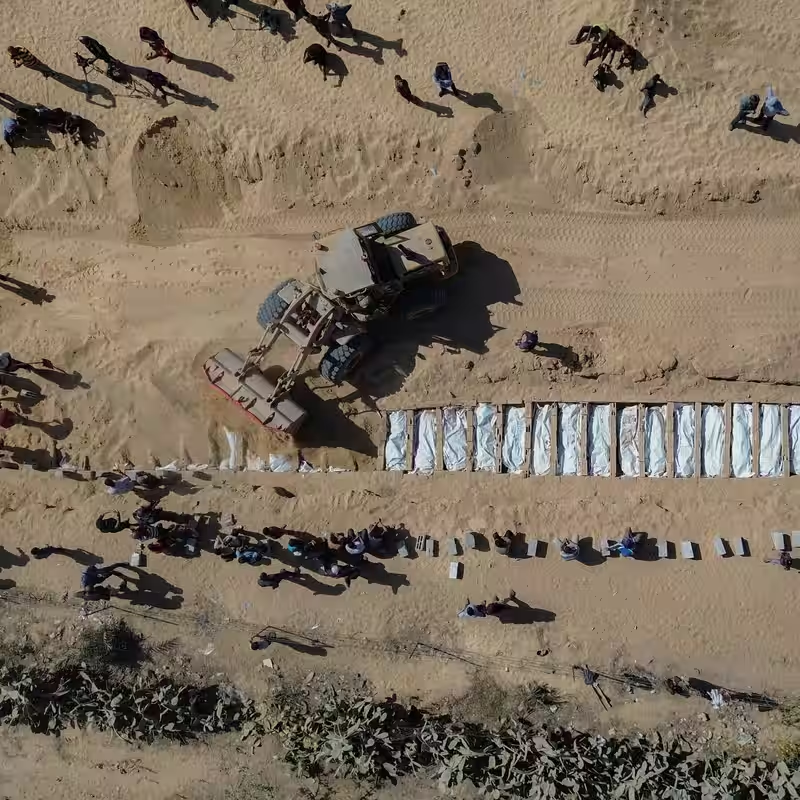Table of Contents
- A Ceremony for the Unknown
- Ceasefire Deal Drives Remains Exchange
- Identification Crisis in Gaza
- Israel’s Claim and Verification Challenges
- Emotional Toll on Families
- International Response
- Sources
A Ceremony for the Unknown
In the sandy soil of Deir al-Balah, central Gaza, 54 bodies wrapped in tarpaulin were laid to rest on Wednesday in a solemn mass burial. None had names. Most had no faces left to recognize. These were the unidentified dead—Palestinians whose remains were recently returned by Israeli authorities as part of an ongoing ceasefire agreement between Israel and Hamas.
Clad in hazmat suits, gravediggers and forensic workers moved the bodies from a bulldozer to freshly dug trenches. Behind them, Palestinian Islamic Jihad flags fluttered as officials from the Hamas-backed government addressed a small crowd of mourners and journalists.
Ceasefire Deal Drives Remains Exchange
The burial follows a fragile U.S.-brokered truce, championed by the Trump administration, which includes provisions for the mutual exchange of human remains. While Israel has released dozens of Palestinian bodies, and Hamas has handed over Israeli soldiers’ remains, the process has unearthed a grim reality: Gaza’s overwhelmed medical system can’t identify most of the returned corpses.
According to doctors at Nasser Hospital, roughly two-thirds of the bodies received lack sufficient distinguishing features—due to decomposition, trauma, or missing documentation—making identification nearly impossible.
Identification Crisis in Gaza
Gaza’s forensic infrastructure has been decimated by months of bombardment. Morgues are nonfunctional, DNA labs are offline, and many civil records have been destroyed. Without fingerprints, dental records, or genetic samples from relatives, health officials are left guessing.
“We receive the bodies, but we cannot tell families who they lost,” said Dr. Ahmed Al-Masri, a forensic pathologist at Nasser Hospital. “It’s a tragedy within a tragedy.”
Israel’s Claim and Verification Challenges
The Israeli military stated that the deceased were “combatants in the Gaza Strip.” However, The New York Times noted it could not independently verify that assertion. Human rights groups have long warned that Israel’s broad definition of “combatant” often includes civilians caught near militant activity.
Without transparent forensic protocols or third-party oversight, families are left in agonizing uncertainty: Was their son a fighter? A bystander? Or simply in the wrong place when a strike hit?
Emotional Toll on Families
For many in Gaza, burial without identification denies a fundamental human right: to mourn a named loved one. Islamic tradition emphasizes proper burial rites and knowing the deceased’s identity. Mass graves of the unknown defy that sacred practice.
“I buried a body, but I don’t know if it’s my brother,” said Fatima Hassan, 34, whose sibling went missing during an airstrike in Khan Younis. “How do I grieve? How do I pray for him?”
International Response
Humanitarian organizations, including the International Committee of the Red Cross, have called for neutral forensic teams to assist in identification efforts. The U.N. has urged both sides to share all available data—including GPS coordinates of recovery sites and pre-death biometric records—to ease the process.
Yet with the ceasefire still tenuous and trust at an all-time low, cooperation remains minimal. For now, Gaza’s unknown dead are buried in silence—nameless, faceless, but not forgotten.




